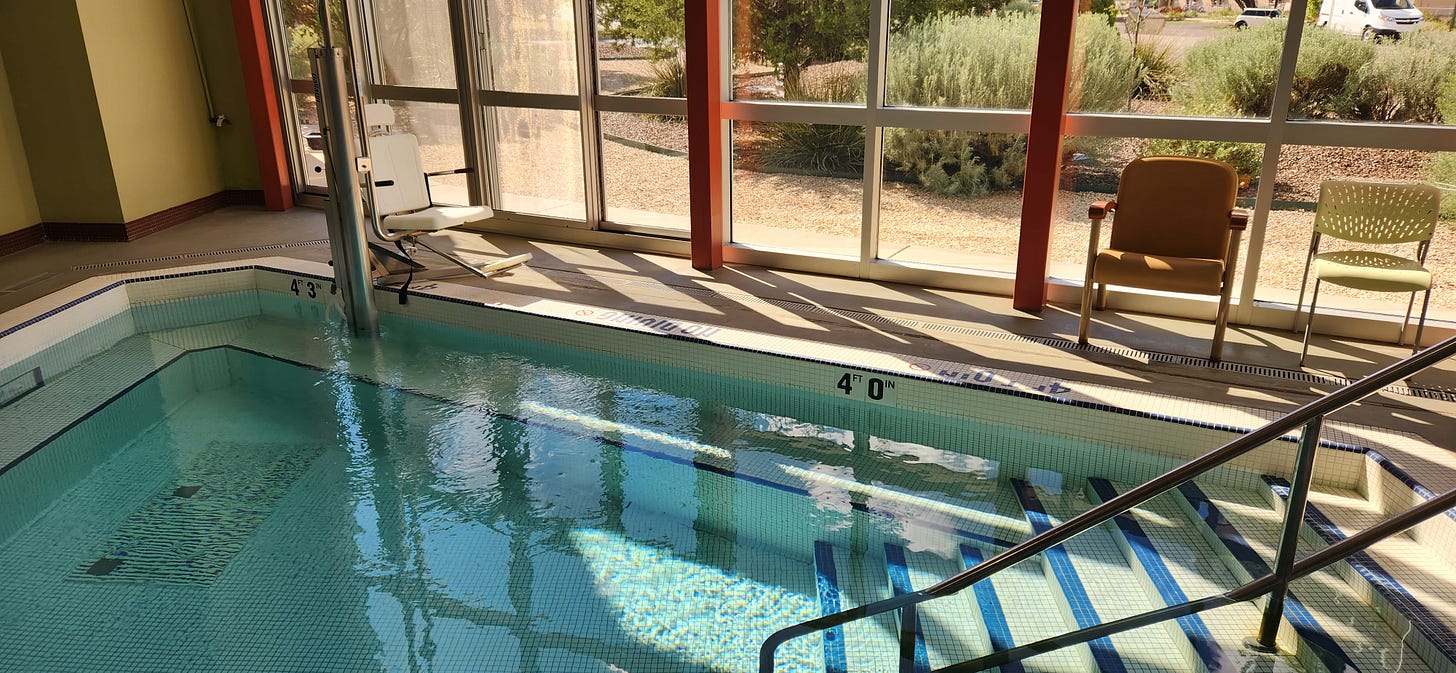This is not medical advice.

I discuss the positives and negatives of pool therapy later in the article, if you want to skip ahead.
In the 90’s I worked at a large clinic that had 2 pools, one cold water lap pool, and one very large heated therapy pool. I can’t remember if there was a Medicare limit of patients to therapy personnel, but I’m going to guess I saw an average of 6 people in group pool sessions.
The pool was heated to between 90-95 degrees, and mostly 4 feet deep. I grew up back East swimming in any body of water, at all ages. I was surprised to find many people in New Mexico, who were afraid of the water. Even if it wasn’t above their head. Many people’s legs would float, and the water would upend them.
Sometimes the pool became a dumping ground for difficult or lazy patients. I remember some of the therapists walking into the pool area and saying, so and so is going to be joining you…They usually looked exhausted.
Some patients were legitimately benefiting from being in the pool. Some saw it as a spa, and did as little as possible.
The Good
If you stand in the pool, and the water is at chest level, you only weigh 25% of land weight. This is a tremendous advantage. I have seen patients in the pool who were unable to walk on land. That is a game changer for many people, and has far reaching implications for strength, mobility, and at decreasing pain. Someone who limps on land may be able walk in the water without limping, and without pain.
People who have had a leg fracture, and are allowed some weight bearing, and their wounds are closed, can learn to walk again.
People with osteoarthritis may be able to do more in the pool, and it especially feels good in the warm water.
The important thing to remember in any rehab, is there needs to be a gradual increase in weightbearing to make progress. So if people always stay in the deep end, they will never get stronger. Over the weeks, they need to start walking in the more shallow end, or walk halfway up the stairs, to gradually increase weightbearing tolerance.
The Bad
Some people would benefit from increased weight bearing, for more strength. Sometimes the pool is too easy, and is not going to increase muscle strength. It can have the opposite effect. People always note how hard it is getting out of the pool, as gravity returns. That last hour did not make us stronger, it might have made us weaker.
Shoulders
Some shoulders can benefit from the warm water and gentle movement. One negative is that there is no overhead range of motion in the pool. Overhead motion is usually the critical motion that is lacking with shoulders. I know that you’re thinking, yes but I’ll swim, but I’m referring to severe cases. If you can lift your arm out of the water, your shoulder is functioning relatively well.




Hydrotherapy can be a great tool for some people for some things. As you say it has different roles.
Where it starts to get into some less convincing territory is when it begins to purely fill a fitness void as opposed to a rehab one. You mentioned certain types that might end up in this :)
Maybe a patient went in for conservative treatment instead of surgery and the HT is not solving what they want, but it's making them a bit fitter and upping their exercise tolerance (which they can't even monitor themselves in a lot of cases.), and actually helping towards what they think surgery should do. So they think the HT is doing nothing. It actually is doing something, but not what they went in for.
So they get the surgery, the HT having failed in their mind, only to be put back in HT again post-surgery as a kind of rehab. The surgery didn't actually work. The HT works a bit again for their general fitness which they can't feel, but that can be seen. 2 years later, rinse, repeat.